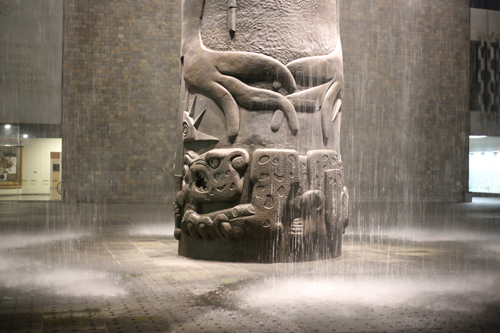The Mayans and the Aztecs were little more than a seventh grade history lesson before visiting the National Archeology Museum in Mexico City. Here, the civilizations came alive through the remains of long dead rock, carved into stories both intentional and functional.


We arrived at the Museum after dark, greeted by the sounds of the wind and pounding rain from the fountain in the outdoor plaza. The fountain introduced us to the story of Mexico, using images to give homage to an Aztec legend that is now represented on the Mexican flag. In this legend, a god in a dream visited the leader of a nomadic tribe. The god told the leader that when the tribe saw an eagle, perched on a cactus, eating a snake, they were to settle there. This, of course, happened in Mexico City, then known as Tenochtitlan.
Inside, we were captivated by the richness of the beliefs that led their lives. The gods drove almost all of their actions, as they believed they had the power to control everything, including the rising and falling of the sun. In fact, they played a game to represent the battle between day and night to keep the gods happy, often ending in sacrifice of a player or even the whole team, though it is unclear whether the winning or losing team would be killed as sacrifice was an honor.


From drawings on walls and in scrolls we see that they believed heaven to be underground, and didn’t have a concept of good and bad. No action on earth would be punished, per say, you just died one way or another, and that would determine your experience in the afterlife. For example, warriors who died in battle would have a pleasant afterlife, while people who died of natural causes may have a less pleasant afterlife.
We travel often, and rarely see things that are truly foreign. Everyone we meet is driven by love. Everyone we meet has a desire to protect his or her family. Everyone we meet wants to be happy. But this, this was foreign. It seemed irrational at best, stupid at worst, and it took some time for us to remove judgment and listen. Perhaps the thing we have most in common is that we’re all looking for meaning, and long ago that meaning was found in the building of incredible pyramids, one stone at a time.













